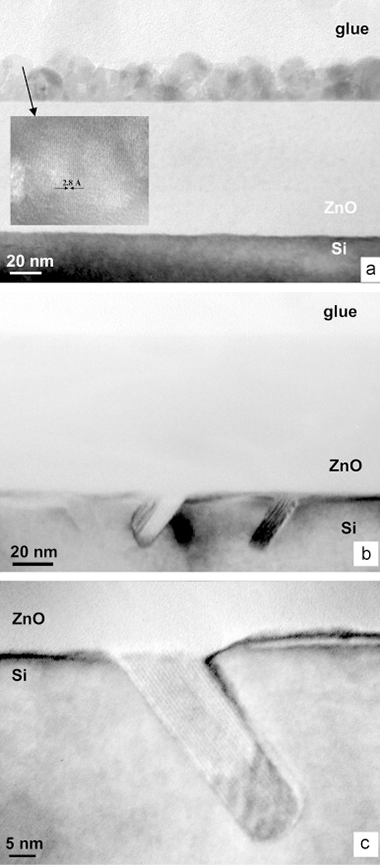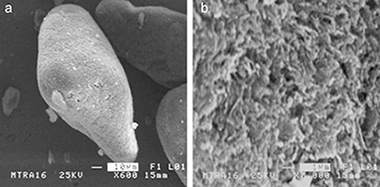Artículos SCI
2009
2009
Materiales Nanoestructurados y Microestructura
Comparative investigation of TiAlC(N), TiCrAlC(N), and CrAlC(N) coatings deposited by sputtering of МАХ-phase Ti2 − хCrхAlC targets
Shtansky, DV; Kiryukhantsev-Korneev, PV; Sheveyko, AN; Mavrin, BN; Rojas, C; Fernandez, A; Levashov, EASurface and Coatings Technology, 203 (2009) 3595-3609
Show abstract ▽

A comparative investigation of the structure and properties of TiAlC(N), TiCrAlC(N), and CrAlC(N) coatings deposited by sputtering of МАХ-phase Ti2 − хCrхAlC targets (where x = 0, 0.5, 1.5, and 2) in an Ar atmosphere or in a gaseous mixture of Ar + N2 is presented. The coatings were characterized in terms of their structure, elemental and phase composition, hardness, elastic modulus, elastic recovery, thermal stability, friction coefficient, wear rate, corrosion, and high-temperature oxidation resistance. The structure of the coatings was studied by means of X-ray diffraction, scanning and transmission electron microscopy, X-ray photoelectron spectroscopy, glow discharge optical emission spectroscopy, electron energy loss spectroscopy, and Raman spectroscopy. To evaluate the thermal stability and oxidation resistance, the coatings were annealed either in vacuum or in air at temperatures 600–1200 °C. The results obtained show that the TiAlCN coatings possess high hardness of 32–35 GPa, low friction coefficient against WC–Co well below 0.25, high thermal stability up to 1200 °C, and superior performance in dry milling tests against high Cr steel. Meanwhile, the coatings with high Cr content demonstrated improved oxidation resistance up to 1000 °C and superior electrochemical behavior, but their mechanical and tribological properties were deteriorated.
Agosto, 2009 | DOI: 10.1016/j.surfcoat.2009.05.036
Materiales y Procesos Catalíticos de Interés Ambiental y Energético
Structural characteristics and morphology of SmxCe1−xO2−x/2 thin films
Hartmanova, M; Jergel, M; Mansilla, C; Holgado, JP; Zemek, J; Jurek, K; Kundracik, FApplied Surface Science, 255 (2009) 9085-9091
Show abstract ▽

Effect of the deposition temperature (200 and 500 °C) and composition of SmxCe1−xO2−x/2 (x = 0, 10.9–15.9 mol%) thin films prepared by electron beam physical vapor deposition (EB-PVD) and Ar+ ion beam assisted deposition (IBAD) combined with EB-PVD on structural characteristics and morphology/microstructure was investigated. The X-ray photoelectron spectroscopy (XPS) of the surface and electron probe microanalysis (EPMA) of the bulk of the film revealed the dominant occurrence of Ce4+ oxidation state, suggesting the presence of CeO2 phase, which was confirmed by X-ray diffraction (XRD). The Ce3+ oxidation states corresponding to Ce2O3 phase were in minority. The XRD and scanning electron microscopy (SEM) showed the polycrystalline columnar structure and a rooftop morphology of the surface. Effects of the preparation conditions (temperature, composition, IBAD) on the lattice parameter, grain size, perfection of the columnar growth and its impact on the surface morphology are analyzed and discussed.
Agosto, 2009 | DOI: 10.1016/j.apsusc.2009.06.108
Materiales Nanoestructurados y Microestructura
Chemical and electronic interface structure of spray pyrolysis deposited undoped and Al-doped ZnO thin films on a commercial Cz-Si solar cell substrate
Gabas, M; Barrett, NT; Ramos-Barrado, JR; Gota, S; Rojas, TC; Lopez-Escalante, MCSolar Energy Materials and Solar Cells, 93 (2009) 1356-1365
Show abstract ▽

We have studied differences in the interface between undoped and Al-doped ZnO thin films deposited on commercial Si solar cell substrates. The undoped ZnO film is significantly thicker than the Al-doped film for the same deposition time. An extended silicate-like interface is present in both samples. Transmission electron microscopy (TEM) and photoelectron spectroscopy (PES) probe the presence of a zinc silicate and several Si oxides in both cases. Although Al doping improves the conductivity of ZnO, we present evidence for Al segregation at the interface during deposition on the Si substrate and suggest the presence of considerable fixed charge near the oxidized Si interface layer. The induced distortion in the valence band, compared to that of undoped ZnO, could be responsible for considerable reduction in the solar cell performance.
Agosto, 2009 | DOI: 10.1016/j.solmat.2009.02.018
Nanotecnología en Superficies y Plasma
Identification of hydrogen and deuterium at the surface of water ice by reflection electron energy loss spectroscopy
Yubero, F; Tokesi, KApplied Physics Letters, 95 (2009) 084101
Show abstract ▽

A nondestructive method to distinguish between hydrogen (H) and deuterium (D) at surfaces by reflection electron energy loss spectroscopy is presented. It is based on the analysis of the energy distributions of electrons elastically backscattered from surfaces containing H or D. We consider standard and deuterated water ices as test surfaces. The recoil energy of the backscattered electrons depends on the atomic mass of the targets, and the contributions of H, D, and O to the measured spectra can be easily separated. The results of Monte Carlo simulations corroborate the experimental findings.
Agosto, 2009 | DOI: 10.1063/1.3202402
Reactividad de Sólidos
High surface area α-alumina preparation by using urban waste
Martin-Ruiz, MM; Perez-Maqueda, LA; Cordero, T; Balek, V; Subrt, J; Murafa, N; Pascual-Cosp, JCeramics International, 35 (2009) 2111-2117
Show abstract ▽

A new method for preparing high surface area α-alumina from urban waste is proposed. The method consists of the precipitation of a precursor that contains bohemite mixed with a linear polymer and subsequently the thermal decomposition of the precursor by heating in nitrogen and air to 1200 °C. The resulting α-alumina consists of nanocrystals of about 100 nm aggregated into larger particles with relatively high surface area (12 m2 g−1) and a significant macropore volume of 0.545 cm3 g. Methods of X-ray diffraction (XRD), scanning electron microscopy (SEM), high-resolution transmission electron microscopy (HRTEM) and selected area electron diffraction (SAED) were used to characterize microstructure of prepared materials. Results of differential thermal analysis, thermogravimetry and emanation thermal analysis characterized the thermal behaviour of α-alumina precursors.
Agosto, 2009 | DOI: 10.1016/j.ceramint.2008.11.011
- ‹ anterior
- 392 of 422
- siguiente ›














